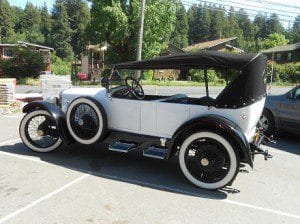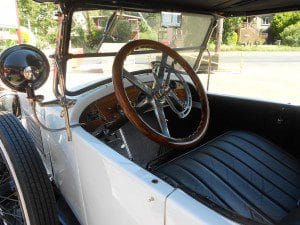The Stutz Bearcat was a creation of Harry C. Stutz and his Stutz Motor Car Company. Stutz was an engineer and became involved with automobiles right after the turn of the century in 1903. Interestingly enough, the first company Stutz founded in 1910 was the Stutz Auto Parts Company. Shortly afterwards the company got into auto building and the Stutz Motor Car Company was founded.

The first car that was put together was the Stutz Roadster. The story is that Stutz produced the automobile in just five weeks.
The car was entered in the very first Indianapolis 500 Race on May 30, 1911. During this historic 1905 race, the Stutz Roadster attained an average speed of 68 MPH and finished in 11th place.
The 1905 Indianapolis 500 was a great venue for the public to get acquainted with the Stutz Motor Car Company and it’s talented engineer owner.
The Stutz Bearcat came along a year later in 1912. The Indianapolis 500 Race became the place for car manufacturers to showcase their creations and the Stutz Bearcat took full advantage. The Bearcat amazingly won some 25 of 30 races it was entered into in 1912. In 1913, the Bearcat came in 3rd at Indy. The car did quite well again at Indy in 1915.
As far as the Stutz Motor Car Company was concerned, due to the need for large amounts of capital to expand, Harry Stutz ended up selling out controlling interest to a New York investor in 1919. Harry Stutz would later get into manufacturing fire engines which were also changing significantly in design and function.

Today, there is a 1921 Stutz Fire engine on display at the Oklahoma Firefighters Museum in Oklahoma City. Additionally, there is a 1925 Stutz Fire Engine Model K-3 on display at the Los Angeles County Fire Museum. The museum is located in Bellflower California.
The Bearcat’s Popularity
The Bearcat was an automobile that was popular with buyers looking for an everyday vehicle yet with a strong racing flare. The car was essentially a cross between a street car and a race car. The Stutz Bearcat was priced at least twice that of the ordinary automobile.
The 1914 model car was selling for $2,000. The car continued to sell quite well after World War One during the Roaring Twenties. Some would say that the Stutz Bearcat was THE car of the Roaring Twenties. The economy was doing well and the prices of the Bearcats climbed. The customer for the Bearcat would have been someone with the money to pay perhaps three times the price of an ordinary automobile with a desire for a sporty set of wheels. The Stutz Bearcat was offered to the public until 1924.

After the mid 1920’s the Bearcat name disappeared until the year 1931.
The reappearance of the Bearcat name had everything to do with the Great Depression. The high end Stutz automobiles had a rough time after the stock market crash of 1929. To try to jump start sales, the company decided to reintroduce the Bearcat name in 1931.
The new Bearcat had an eight cylinder engine and claimed to be tested to 100 MPH, an extraordinary speed for an automobile in 1931, especially a car to be driven off the raceway. The Stutz Motor Car Company ceased production altogether in 1934. The Stutz Bearcat and the Stutz company was one of several auto companies claimed by the Great Depression.
Automobile enthusiasts know quite well that the Stutz Bearcat automobile remains today one of the most popular vintage cars. Today, you can see the Stutz Bearcat automobile on display at several venues around the United States.
Among the many automotive museums where this vintage car is on display are, the Petersen Automotive Museum in Los Angeles, the National Auto Museum in Reno Nevada, the Wells Auto Museum in Wells Maine, the Blackhawk Museum in Danville California about 25 miles east of the San Francisco Bay area, the Graceland Car Museum in Memphis Tennessee and at the Henry Ford Museum in Dearborn Michigan, a Detroit suburb.
(Photos are from author’s private collection)